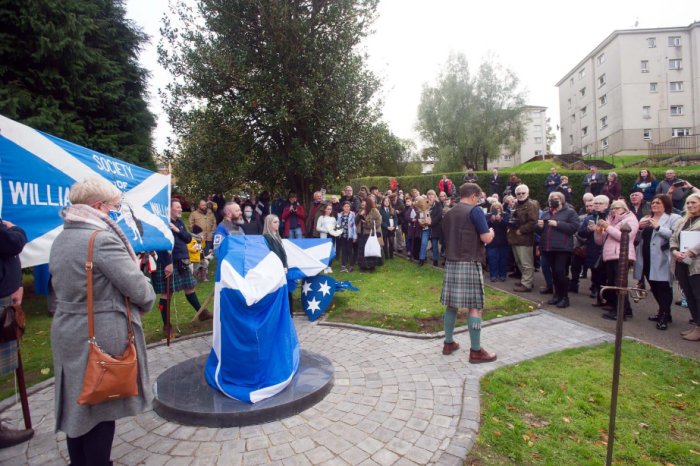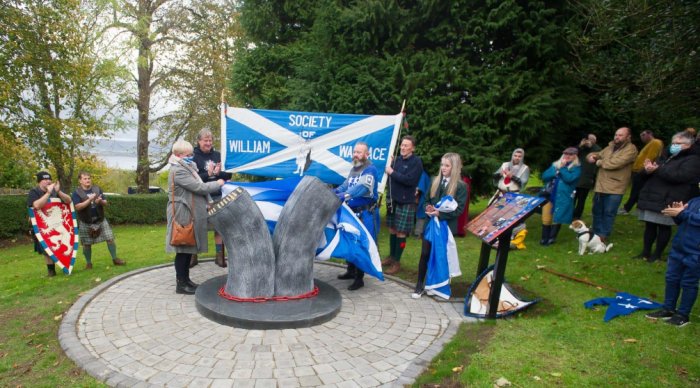THE WALLACE OAK PROJECT TIMELINE |
1. 3rd of August 1305 : Sir William Wallace is captured at Robroyston near Glasgow. He is quickly taken to the most secure place in the area - the Earl of Menteith’s stronghold of Dumbarton Castle.
| ||||
 |
||||
The Wallace Oak before it fell during a storm in 1992 |
||||
7. 1959 : The building of the new Holy Family Roman Catholic Church was completed. Many a family was to have photographs taken beside the Wallace Oak at celebrations such as weddings, christenings and First Holy Communions - even some Holy Family Primary school football team line ups.
| ||||
 |
||||
A section of the Wallace Oak still had an old chain enveloped in its bark |
||||
9. January 1962 : Greenock Telegraph issued a plea from local man J.B. Scrymgeour to once again save the ailing Wallace oak as it had started to split. Whatever action was taken, it again survived.
| ||||
 |
||||
The Wallace Bar built just along the road from the church showing an Oak tree in its name |
||||
11. Monday 29th June 1992 : Sadly, the gnarled Wallace Oak finally fell to ground during a storm, leaving behind a mystery. Fr Joseph Quinn witnessed its demise. There was no thunderous crash - it went quietly with one long, creaking groan.
| ||||
 |
||||
Father Quinn with the fallen Oak in 1992 |
||||
12. 1992 : Fr Quinn sought help to remove the stricken Wallace Oak, and local businessman David Smith from Bouverie Motors came along with a tow truck and cleared the site. But before he did, parishioner Mr Joseph Delaney asked for a large branch and proceeded to carve one large and seven small Padre Pio statues. One still resides at the church to this day. He also planted some acorns collected from the site in his daughter’s garden and they continue to grow there.
| ||||
 |
||||
Local man Joseph Delaney who carved 8 Padre Pio likenesses from a branch he saved as the Wallace Oak was removed from the church |
||||
13. Mid 1990’s : During research for his book “On the Trail of William Wallace”, the late David R Ross (then convenor of the Society of William Wallace) visited the site to see the Wallace Oak, only to be told it had fallen some 18 months before his visit.
| ||||
15. January 2014 : The first story of the Wallace Oak in almost 22 years appears in the Greenock Telegraph with an appeal for any information. Within days there are twenty five replies with helpful information, resulting in contact being made with both Joe Delaney and David Smith and a colour picture of the oak from local man John Scott.
| ||||
 |
||||
The Greenock Telegraph article. |
||||
 |
||||
Wallace Oak remains are found in a scrap yard owned by David Smith of Bouverie Motors. |
||||
16. May 2014 : The then Society of William Wallace convenor, the late Duncan Fenton, meets with David Smith to view the two remaining sections of the tree held in David’s disused scrapyard where he had placed them some 22 years previously. In a meeting covered by the Greenock Telegraph, Mr Smith donates the Wallace Oak to the SOWW.
| ||||
 |
||||
Dr Coralie Mills visiting the site before taking samples to be tested. |
||||
20. March 2016 : Sean is interviewed on BBC Radio Scotland about our historical find.
| ||||
 |
||||
The Wallace Oak is removed by Wallace Civil Engineering to an industrial unit in Port Glasgow kindly donated by Newark Products. |
||||
23. February 2017 : a presentation made to David Smith at Bouverie Motors by the SOWW for his help with the Wallace Oak is covered by the Greenock Telegraph.
| ||||
 |
||||
Planning permission granted, our design is approved |
||||
 |
||||
Greenock Telegraph article 13th May 2021 |
||||
33. 23rd October 2021 : The monument is finally unveiled to the public, 26 years after the tree fell and 716 years after Sir William Wallace had been chained there.
| ||||
 |
||||
 |
||||
34. October 2021 : After the unveiling, Clan Hunter approaches the Wallace Oak Project team offering to temporarily house the oak section and Hunterston Castle.
| ||||
37. October 2022 : A joint team from The Society of William Wallace and Clan Hunter successfully manoeuvre Wallace Oak section into a room in the basement of Hunterston Castle and begin to prepare the artefact for public display.
| ||||
38. May 2024 : the last remaining section of the Wallace Oak is installed at Hunterston Castle, North Ayrshire, courtesy of Clan Hunter Chief Madam Pauline of Hunterston on May 21st. It can be viewed by booking a tour on Clan Hunter's official website: |
THE WALLACE OAK PROJECT ROLL OF HONOUR |
For support in the advancement of these projects, the following (in alphabetical order) are inducted into the Wallace Oak Project Roll of Honour :
Aileen Thomson
Alexis Tennant
Alistair Wilson
Andrew Hillhouse Artist
Alastair McDonald (Folk Singer)
Brian Campbell
Brian McKenna
Brian Roy
Bonny Boyle
Bruce Martin
Carol Chalmers
Caroline Duncan
Charlie Sutherland
Chris Curley
Chris Jewell and Discover Inverclyde
Chris Nimmo
Clark Millar
Connie Eggers
Conor Woods
Coralie Mills, Dendrochronologist
Craig Burns
David Lockhart
David Smith, Bouverie Motors
Debra Johnson
Duncan Spiers
Donald McRae
Edward Raupp
Elaine McLoughlin
Everyone who purchased our Wallace Oak souvenirs and merchandise
Fran Blyth
Frankie Caldwell
Freedom Tours Today (Stirling)
Gary Stewart
George Kempik
George Mair
Geraldine Harron
Gordon Aitken
Gordon Derby
Greenock Telegraph (Paul John Coulter, George Munro, Russell Steele, Claire Amber Young)
Heather Dowds
Helen Tennant
Hilary Murdoch
Holy Family Roman Catholic Church, Port Glasgow, priests and the parish council
Hugh Cassidy
Hugh Ferns
Iain Rodger
Inverclyde Council
Inverclyde Powder Coating
Jacqui Munro
James Binnie
James McCleary
Jane Gubb-Wallace
Janice Donnelly
Jared Stafford
John Muir
Joseph Delaney
June Wallace
Lewis Macdonald
Lisa Jean Halliday
Liz Hughes
Lorraine Hunter
Madam Pauline of Hunterston, 30th Chief of Clan Hunter
Mags Halliday
Martin Beer
Martin Coyle
Michael Parker
Nicholson McShane Architects
Newark Primary School (pupils and staff)
Patricia Clint
Patrick Herman
Paul Graham
Picture Your Frame (Greenock)
Queensferry Renaissance Festival, Oklahoma
Rebecca Allison
River Clyde Homes
Riverside Inverclyde
Rob Thomson (Conservator)
Robert Halliday
Robert Inglis
Ronald H Sinclair
Rosaleen Shields
Ryan Deegan
Scott Halliday
Sherry Byrd
Steven Hughes, Freedom Tour Today
Stevie Webster
Stewart Gunn
St Francis’ Primary School, Port Glasgow (pupils and staff)
St John’s Primary School, Port Glasgow (pupils and staff)
St Michael’s Primary School, Port Glasgow (pupils and staff)
Stuart McMillan MSP
Tami Robertson
The Society of William Wallace committee
The Trust (Port Glasgow)
Tom Kielty
Union Projects
Wallace Civil Engineering
William Wallace
Whiteside Memorials
Vicki Shields
Vicky Hillhouse
| © Society of William Wallace 2007-2026 | The Society of William Wallace is a Scottish Charitable Incorporated Organisation Registration number SC045959 |
